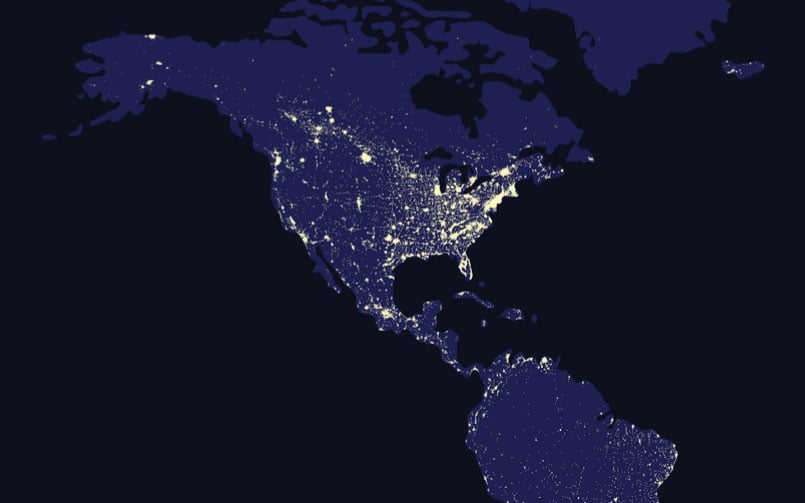Light pollution reduction is something our nation has been working on for years, and yet it seems to continually get worse. There are several things you can do to help reduce light pollution, and you might even save some money in the process.
- 40% of light pollution is created by productive lights that are necessary for a functioning society.
- 10% of light pollution comes from light glare.
- And a frightening 50% of light pollution is produced by waste—light that no one even needs.
Is there a light on your building, home, or street that stays on all night long, even when it really serves no other purpose other than maybe peace of mind? It’s so common, and that’s why so much wasted light contributes to light pollution.
What is Light Pollution?
Light pollution, technically known as photopollution, is defined as the “presence of anthropogenic light in the night environment.” Just like other types of pollution, light pollution has several negative effects on our Planet.
The Earth is supposed to be dark for X number of hours every 24-hour cycle. Light pollution disrupts the natural circadian rhythms, or the 24-hour process most organisms operate under. As a result, light pollution impacts humans, wildlife, environment, energy resources and more. Plus, when artificial light continues to persist at unnatural times it discolors the night sky and makes it difficult if not impossible to spot stars.
What about light pollution & LEDs?
LED bulbs save money and electricity but researchers say they may put off more light pollution than traditional bulbs. A study out of the GFZ German Research Centre for Geoscience led by Christopher Kyba and published in Science Advances found that light radiating from Earth at night has increased by 2% every year over the past four years. They say this relates to the rapid adoption of bright LED lights.
That doesn’t mean LED lights are on their way out. In fact, well-made LED bulbs have been found to emit less light pollution. Additionally, reducing how often lights are turned on can help reduce the problem, for instance through the installation of automatic light timers and sensors.
5 Tips to Help Light Pollution Reduction
Homeowners, commercial businesses, and entire cities are aiming to reduce light pollution—so what are some things you can do to help in the cause?
#1. Use White LED Bulbs
Compact fluorescent lamps (CFL) and LED bulbs put off a warm white light. This is better than LED lights that emit a short blue wavelength. Shorter blue lights easily scatter throughout the universe and add to light pollution, as well as cause eyestrain. Blue lights are also more difficult for researchers to track when calculating current light pollution levels.
#2. Cutoff Angles are Key
Pick exterior light fixtures that have cutoff angles to help prevent light from leaving the horizontal plane. This also reduces uplighting and high-angle brightness. Cutoff lighting works similarly to adding a shield by concentrating the light at a downward angle and preventing it from radiating up towards the sky. This can help improve overall visibility as well.
There are different types of cutoff angles including:
Full Cutoff: No light emits into the sky past a certain point.
Cutoff: Allows a small amount of uplighting loose up into the sky.
Semi-Cutoff: Even more light is emitted into the sky, but there is still partial control of light and a reduction in overall light pollution.
#3. Add a Shield
Shield outdoor lighting fixtures with a solid cap of some type to prevent light from going off into the sky. This also keeps light directed where it needs to be. There are a variety of shields that can help reduce light pollution.
#4. Add Lighting Sensors for Light Pollution Reduction
Adding motion sensors to lighting fixtures can reduce light pollution considerably by turning fixtures off whenever no one is around or needs them. Instead of leaving lights on all night long and contributing to waste-related light pollution, add a sensor so lights turn on and off as needed. Quality sensors are important to prevent lights from turning on unnecessary, say for instance every time a bird flies by.
#5. Assess Your Needs
Make it your mission to turn off lights when they are not in use. Assess your needs so that you know exactly when you need and don’t need lighting. 50% of light pollution derives from waste—light that is polluting our world for no reason at all. Since waste is the biggest single contributor to light pollution, it’s really the first place to start when creating a plan.
Some questions to ask yourself include: What time can you turn off fixtures because they are no longer necessary? Between when and what time do fixtures need to be on? How frequently over the course of one hour are lights used at different times of the night?
Contact Terracast Products for Dark Sky Compliant luminaries: Contact Us.

